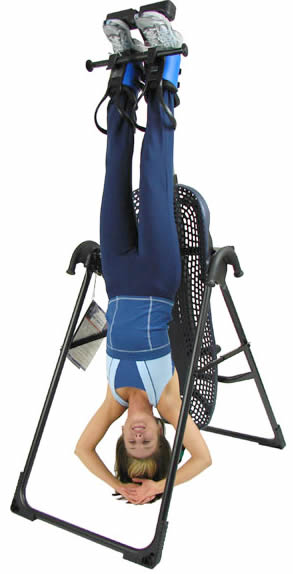Can Inversion Tables be used for Adult Scoliosis Treatment?
Inversion therapy is often marketed as an alternative treatment for adult scoliosis. Inversion therapy involves being upside down or at an inverted angle to take gravitational pressure off the nerve roots and disks of the spine and increases the space between vertebrae for therapeutic benefits. The process of doing so is called inverting. This can be done by Handstands or Headstands, hanging from a bar with arms at sides, or with an inversion machine.
Claims
When the body’s weight is suspended from the lower body, the pull of gravity may decompress the joints of the body. Hanging by the feet, as with gravity boots or inversion tables, causes each joint in the body to be loaded in an equal and opposite manner to standing in an identical position of joint alignment. Inversion therapy is one example of the many ways in which spinal traction (spinal stretching) is implemented to relieve back pain. Studies have found spinal traction provides short-term relief, with some people finding traction very helpful as part of a more complete treatment program for lower back pain caused by spinal disk compression and arthritis.
Health risks
During inversion the heartbeat slows, blood pressure rises, and the pressure inside the eyeballs increases drastically when you remain inverted for more than a couple of minutes. Due to these effects, individuals with heart disease, high blood pressure, eye diseases (such as glaucoma), or those who are pregnant are at higher risk for the dangers related to inversion therapy and should not attempt inversion. Traditionally women were advised not to do inversions while menstruating (some yoga instructors still do). The argument being that inversions might increase the chances of developing endometriosis. However, it is now known that endometriosis is caused by specific cells present in the uterine lining that can possibly develop into endometrial-cells. Still, some doctors advise against inversion during menstruation because it might cause vascular congestion and lead to increased menstrual bleeding.
Sources [1, 2]
The first time anyone tries inversion therapy, they should have someone standing by in the event that they experience any health issues or need assistance.
Individuals with acid reflux could experience painful symptoms from inversion as it can intensify reflux and cause stomach acid to leave the stomach and travel into the esophagus.
Adult Scoliosis Pain Relief from Inversion
Pain is often associated with adult scoliosis and therefore many adult scoliosis patients seek alternative treatments in an attempt to alleviate painful scoliosis symptoms. Stretching is commonly used as an exercise on an inversion table and it may offer temporary pain relief for people with scoliosis. While you are inverted on the table, the effects of gravity are reversed on the spine and the body becomes elongated. Inverting is believed to stimulate the flow of fresh blood through the muscles and fluid into the spinal discs. This provides pain relief temporarily after inversion, but this is not a permanent or long-term solution.
Scoliosis Posture Correction from Inversion
Inversion therapy is promoted by some as a tool for posture correction. The increased blood flow to muscles may help to reduce back spasms. However, this will not realign a scoliotic spine as most current research suggests a neurological underdevelopment to be the cause of idiopathic scoliosis, that requires neuromuscular reeducation treatment. There is no research to substantiate the assumption that inversion therapy can treat or improve scoliosis.
Abdominal Strengthening
The rectus abdominis or abdominal muscles are partly responsible for the forward movement of the spine. Inversion tables can be used to perform sit-ups and crunches that strengthen these muscles. This will strengthen your core, but again it will not impact the size of your scoliosis. Scoliosis is not caused by (or as simple) as poor posture.
Scoliosis is a complex condition that is affected by many unknown factors and varies from patient to patient. According to the National Scoliosis Foundation, 85 percent of scoliosis cases are classified as idiopathic, meaning that the cause is unknown. Research into inversion therapy and spinal traction to treat scoliosis is nonexistent. Inversion therapy might bring temporary relief to adult scoliosis patients, but can only be beneficial as part of a complete scoliosis treatment plan designed by your scoliosis specialist.
Possible Dangers for Scoliosis Patients
While most cases of scoliosis in children are of unknown cause, scoliosis can also result from infection, cancer or other bony or neuromuscular diseases. Children who suffer from scoliosis as a result of these other conditions should not be treated with inversion therapy unless specifically directed to do so by their doctors.
Individuals with surgically implanted rods or supports could damage or loosen these implanted devices during inversion.
Remember, inversion therapy does not provide long-term relief from back pain, and it is not safe for everyone!


